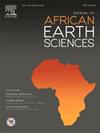区域变形对 Ousdrat 和 Aït Ahmane 矿床热液矿脉的制约(摩洛哥阿特拉斯中部 Bou Azzer-El Graara 山脉):对矿产勘探的影响
IF 2.2
4区 地球科学
Q2 GEOSCIENCES, MULTIDISCIPLINARY
引用次数: 0
摘要
Bou Azzer-El Graara 山脉的构造事件和岩浆事件相互重叠,给了解变形和热液系统之间的绝对和/或相对年代学带来了复杂性。在 Bou Azzer-El Graara 山脉中部偏北地区,约 650 Ma 的 Aït Ahmane 和 Ousdrat 同源岩体在 NE-SW 向缩短和变质条件下发生了变形。这些岩块受到四个主要方向断层系统的影响:N015、N090、N140 和 N040。后两个断层系统的矿化程度最高,但在影响布阿泽尔(Bou Azzer)岩体的变形阶段和充填方式的框架内,对它们的约束较弱。此外,东北-西南断层的泛非、瓦卡托米亚或海西起源尚未确定。本文旨在根据这些断层和矿脉的结构、纹理和形态澄清这些问题。我们的分析强调,这些结构大多是通过开敞空间充填和裂缝-密封-滑动机制形成的。蛇绿岩与石英闪长岩之间的 N140 接触断层在瓦卡多姆期经历了多次重新激活。最古老的活化是在韧性条件下进行的,后来在转位到转张力机制下重新活化,导致 N040 断层因 NNE 应力演化而发展成正弦反断层。实地观察表明,N040 构造影响了埃迪卡拉晚期的瓦尔扎扎特组,但没有影响阿杜杜年地层,这凸显了其起源于瓦卡多米期。N040 构造保留了微尺度的碎屑剪切带。这种演变表明,布阿泽尔内层的热液系统从沿 N140 褶皱接触的韧性-脆性热液方式转变为沿 N040 正弦正断层的脆性热液方式。一些脉内微观纹理表明,这种热液主要赋存于延伸和构造活跃的环境中,延伸中继、句法和反轴纹理以及拉长的晶粒就是证明。因此,对形态、纹理、充填类型和断层运动进行详细分析,是确定 N140 和 N040 矿脉前方变形相对年代的重要工具。本文章由计算机程序翻译,如有差异,请以英文原文为准。
Constraints of the regional deformation on the hydrothermal veins in Ousdrat and Aït Ahmane ore deposits (Bou Azzer-El Graara inlier, central Anti-Atlas, Morocco): Implications for mineral exploration
The overlap of tectonic and magmatic events in the Bou Azzer-El Graara inlier causes a complexity for understanding the absolute and/or relative chronology between the deformation and the hydrothermal system. In the central northern part of the Bou Azzer-El Graara inlier, syn-orogenic ca. 650 Ma Aït Ahmane and Ousdrat plutons have been deformed under NE-SW shortening and with metamorphic conditions. These plutons are affected by fault systems with four mains directions: N015, N090, N140, and N040. The last two fault systems are the most mineralized and they are weakly constrained in the frame of deformation phases affecting the Bou Azzer inlier, and filling style. In addition, Pan-African, WACadomian or Hercynian origin of NE-SW faults is not yet reached. This contribution aims to clarify these issues based on structural, textural and morphological of these faults and veins. Our analyses highlight that most of these structures were formed through open-space filling and crack-seal-slip mechanisms. N140 contacts faults between serpentinite and quartz diorite experienced multiple reactivations during the WACadomian stages. The oldest activation was in ductile condition and later reactivated in a transpression to transtension regime leading to the development of N040 faults as sinistral antithetic faults due to NNE stress evolution. Field observations suggest that N040 structures affect late Ediacaran Ouarzazate Group, but not the Adoudounian Formation, highlight their WACadomian origine. The N040 structures preserve metric to microscopic cataclastic shear zones. This evolution suggests that the hydrothermal system in the Bou Azzer inlier shifted from ductile-brittle hydrothermal style along the N140 foliated contact to a brittle regime along the N040 sinistral-normal faults. Some intra-vein microtextures suggest that this hydrothermal fluid was emplaced in a predominantly extensional and tectonically active environment, as evidenced by extensional relay, syntaxial and antiaxial textures, and elongated grains. Consequently, a detailed analysis of the morphology, textures, filling types, and fault movements is an essential and important tool for establishing the relative chronology of deformation in front of the N140 and N040 veins.
求助全文
通过发布文献求助,成功后即可免费获取论文全文。
去求助
来源期刊

Journal of African Earth Sciences
地学-地球科学综合
CiteScore
4.70
自引率
4.30%
发文量
240
审稿时长
12 months
期刊介绍:
The Journal of African Earth Sciences sees itself as the prime geological journal for all aspects of the Earth Sciences about the African plate. Papers dealing with peripheral areas are welcome if they demonstrate a tight link with Africa.
The Journal publishes high quality, peer-reviewed scientific papers. It is devoted primarily to research papers but short communications relating to new developments of broad interest, reviews and book reviews will also be considered. Papers must have international appeal and should present work of more regional than local significance and dealing with well identified and justified scientific questions. Specialised technical papers, analytical or exploration reports must be avoided. Papers on applied geology should preferably be linked to such core disciplines and must be addressed to a more general geoscientific audience.
 求助内容:
求助内容: 应助结果提醒方式:
应助结果提醒方式:


